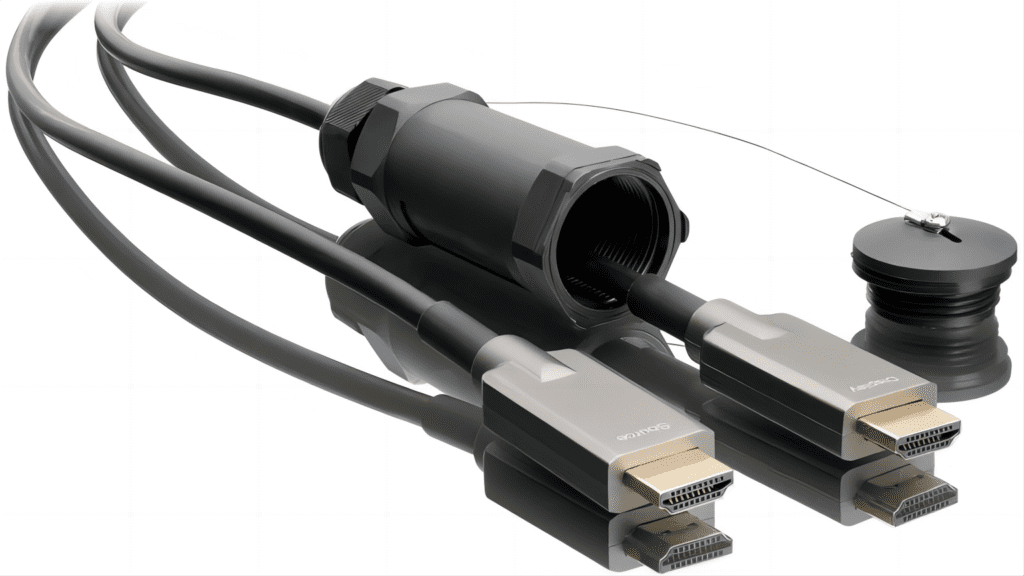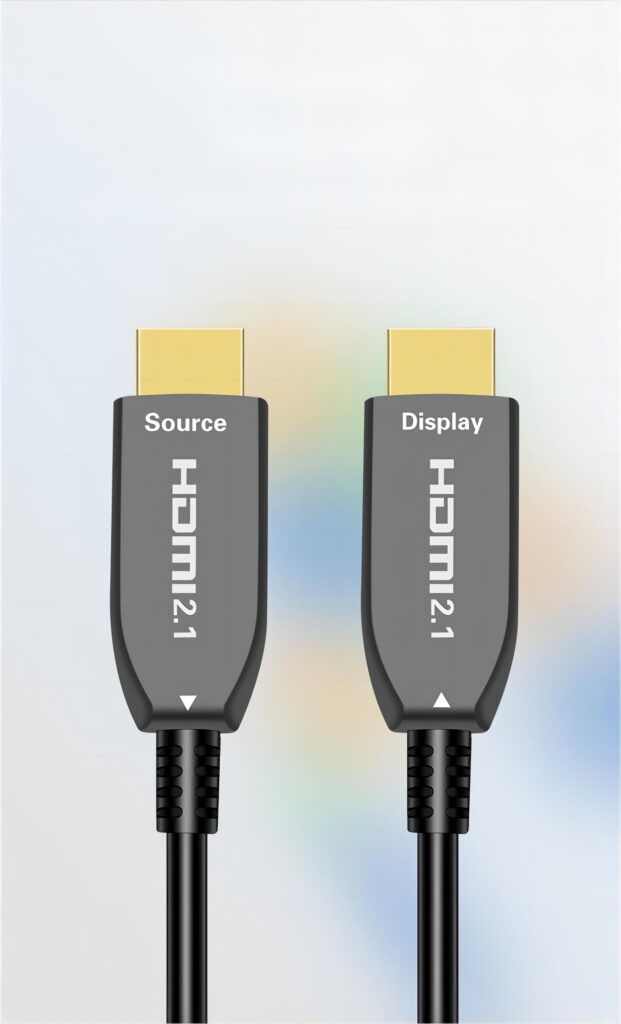A Fiber Optic HDMI Cable, often referred to as an “HDMI Fiber Cable” ,”HDMI Optical Cable,” “HDMI Active Optical Cable” and “HDMI AOC Cable”, is a high-definition multimedia interface (HDMI) cable that uses active optical fiber technology to transmit audio and video signals between devices. Unlike traditional copper-based HDMI cables, which rely on electrical conductors to carry signals, fiber optic HDMI cables use hybrid optical fibers to transmit data using light signals.

What is the difference between Fiber Optic and Copper HDMI Cable ?
Fiber optic HDMI cables and copper HDMI cables serve the same fundamental purpose of transmitting audio and video signals between devices using the HDMI interface. However, they differ significantly in terms of their underlying technology, capabilities, and certain characteristics. Here are the main differences between fiber optic and copper HDMI cables:
- Transmission Medium:
- Fiber Optic HDMI Cable: These cables use optical fibers made of glass or plastic to transmit data using light signals. They are essentially glass strands that carry data via the reflection of light.
- Copper HDMI Cable: Copper HDMI cables use electrical conductors made of copper to carry data using electrical signals.
- Signal Loss and Distance:
- Fiber Optic HDMI Cable: Fiber optic cables are known for their minimal signal loss over long distances. They can transmit HDMI signals reliably over hundreds of meters without degradation.
- Copper HDMI Cable: Copper cables have higher signal attenuation over long distances, which can lead to signal degradation. While short copper HDMI cables are suitable for most home setups, longer cables may require signal boosters or repeaters.
- Bandwidth and Resolution:
- Fiber Optic HDMI Cable: Fiber optic cables can support extremely high bandwidths, making them ideal for transmitting high-resolution video, including 4K, 8K, and beyond, as well as advanced audio formats.
- Copper HDMI Cable: Copper cables also support high-definition video and audio but may have limitations when it comes to very high resolutions and advanced audio formats at longer distances.
- Immunity to Interference:
- Fiber Optic HDMI Cable: Fiber optic cables are immune to electromagnetic interference (EMI) and radiofrequency interference (RFI). They are suitable for environments with high levels of electronic interference.
- Copper HDMI Cable: Copper cables can be susceptible to EMI and RFI, which can affect signal quality in environments with significant electronic interference.
- Size and Flexibility:
- Fiber Optic HDMI Cable: Fiber optic cables are typically thinner, lighter, and more flexible than copper cables. This makes them easier to route and install in tight spaces.
- Copper HDMI Cable: Copper cables are generally thicker and less flexible, which may be a consideration in installations with limited space or complex cable routing.
- Security:
- Fiber Optic HDMI Cable: Fiber optic cables do not emit electromagnetic signals, which can make them more secure in terms of data interception. They are used in secure communication applications.
- Copper HDMI Cable: Copper cables emit electromagnetic signals that can potentially be intercepted or tapped, although this is a concern in specific security-sensitive scenarios.
- Directional: Trandtional copper hdmi cables has no difference on cable heads, while fiber optic hdmi cables are directional. Fiber optic HDMI cable connector heads are marked “Source” and “Display.” Cables must be installed accordingly in order to function correctly.

In summary, the choice between fiber optic and copper HDMI cables depends on factors such as the required distance, resolution, susceptibility to interference, and installation environment. Fiber optic HDMI cables excel in long-distance, high-resolution, and interference-prone settings, while copper HDMI cables are suitable for shorter distances and standard home theater setups.
Why use Fiber Optic HDMI Cable ?
Fiber Optic HDMI cables send data via optical fibers. This means much higher bandwidth capabilities than standard copper cables, as well as longer distances. Our 8K UHD Fiber Optic HDMI Active Optical cables transmit signal at 48 Gbps for up to 150 meters, supporting 30m eARC, which is well outside the capabilities of a standard copper HDMI cable.
